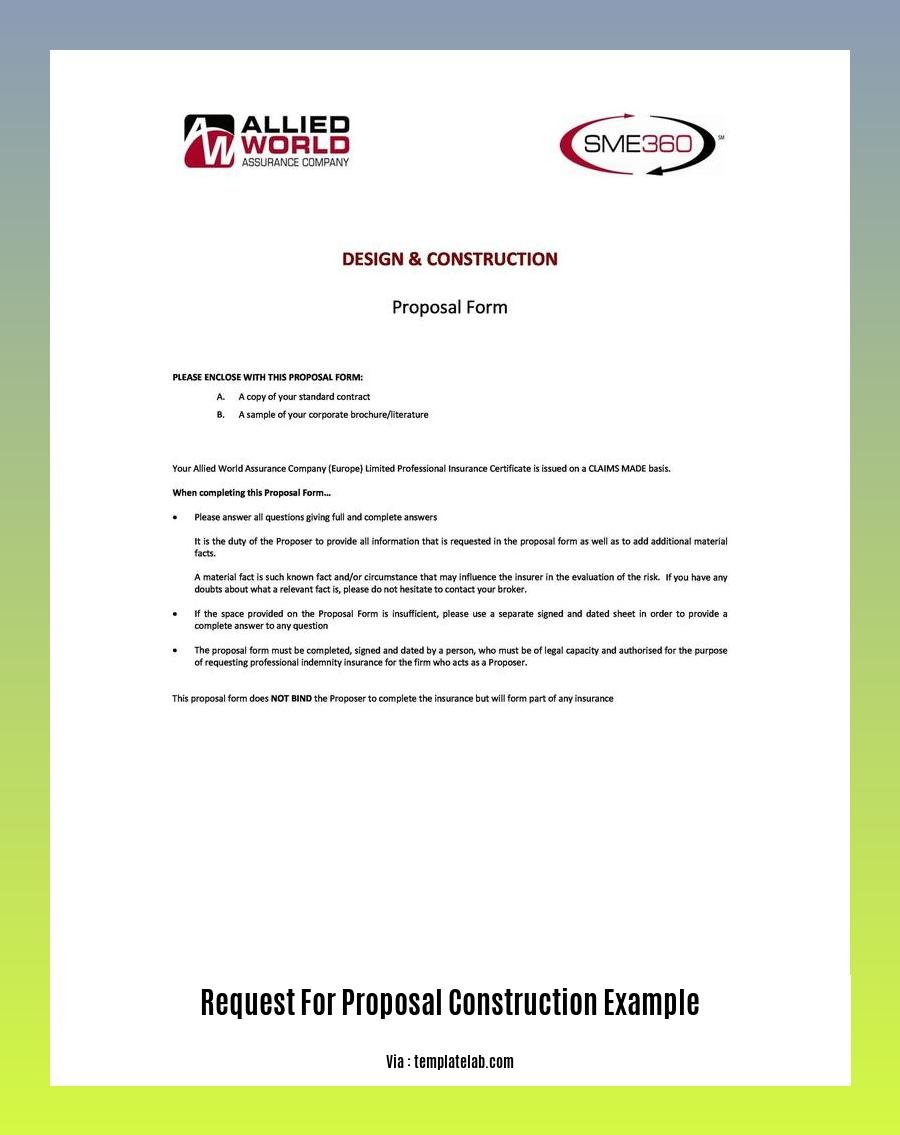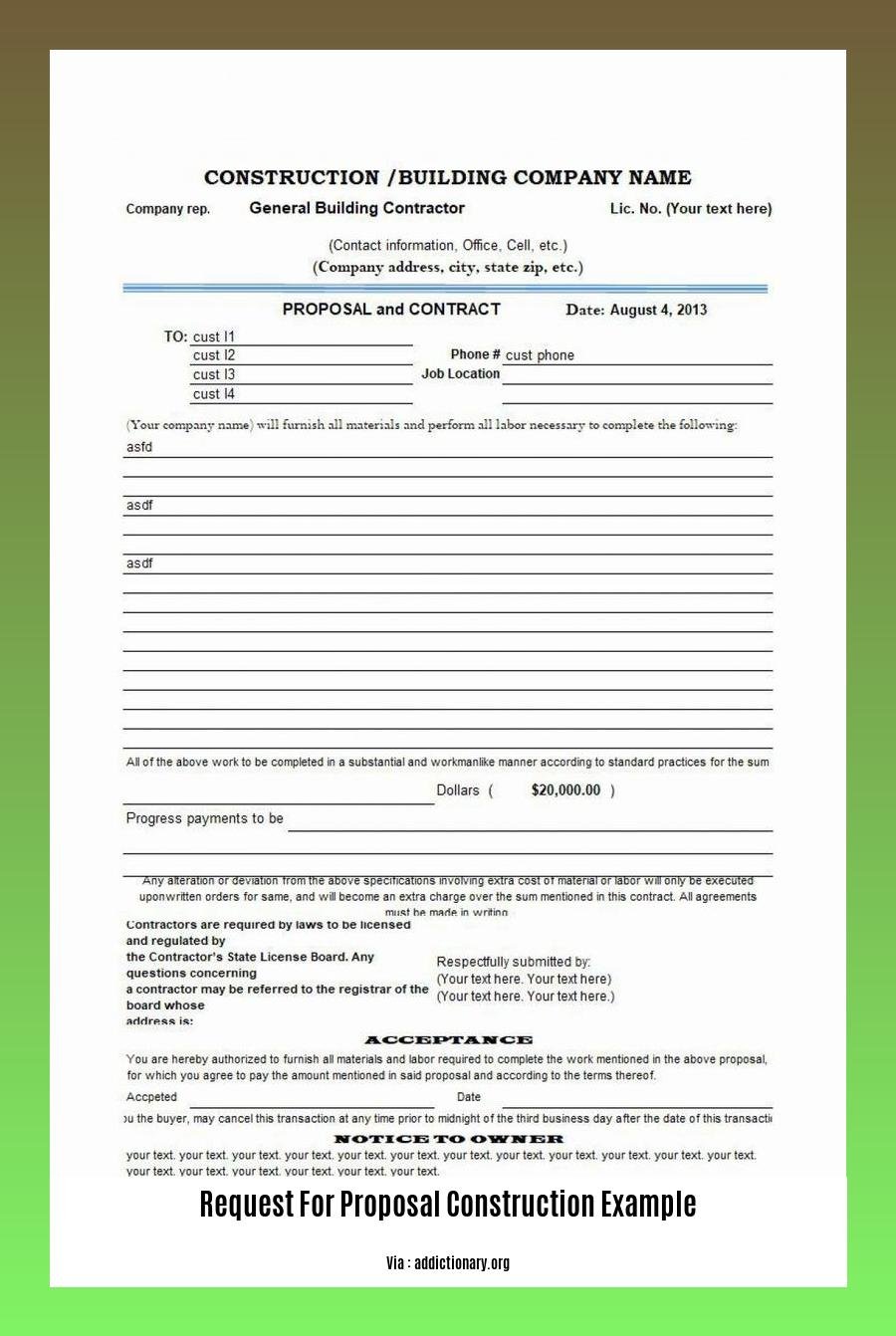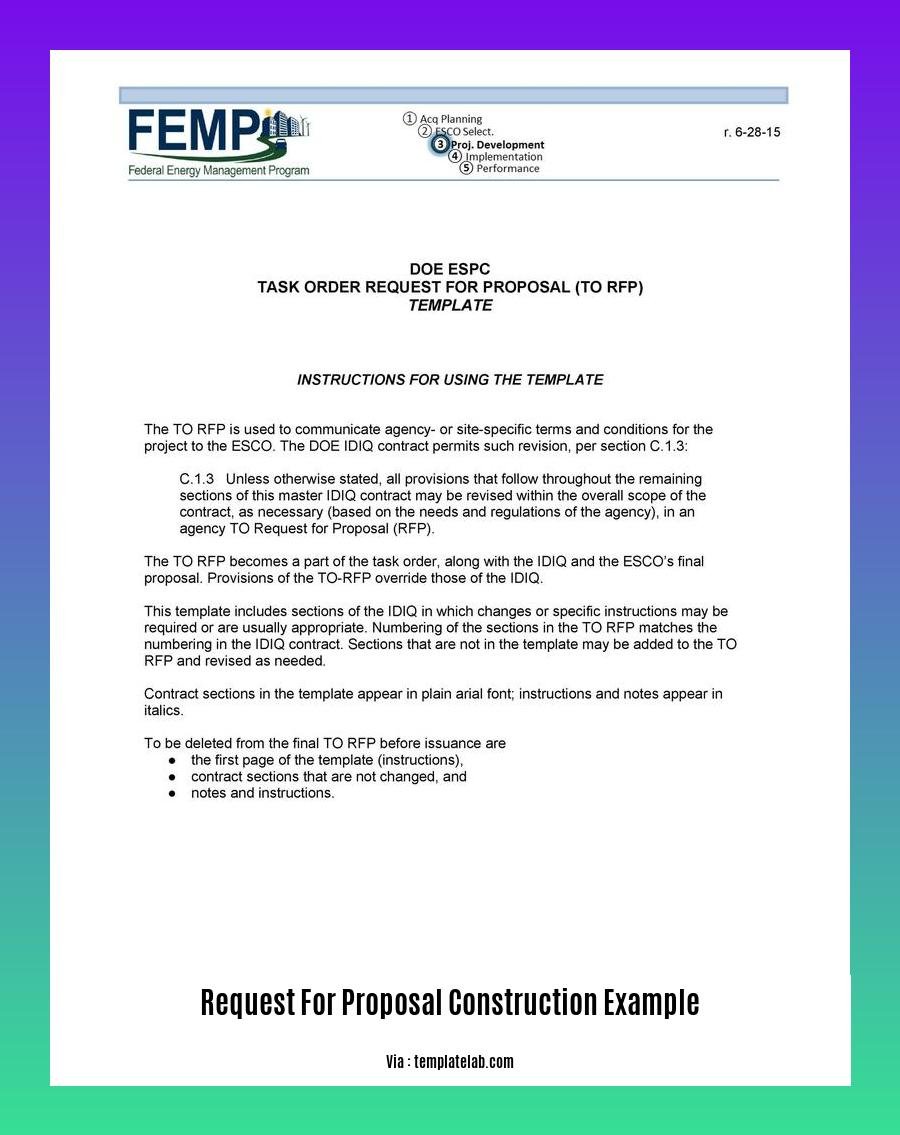Dive into the multifaceted world of Request for Proposals (RFPs) with our comprehensive guide, “Request for Proposal Construction Example for Optimized Procurement.” Whether you’re new to RFPs or looking to enhance your procurement strategies, this article will empower you to navigate the complexities of the RFP process, from understanding its steps to tailoring your RFPs for success in the construction industry.
Key Takeaways:
- RFPs are formal documents used to obtain proposals from contractors.
- Types of RFPs: RFQ (Qualifications), RFI (Information).
- Purpose of RFPs: Assess contractor qualifications and obtain best proposals.
- Benefits of RFPs: Clear project specifications, multiple proposal comparisons, informed decision-making.
Request for Proposal Construction Example

Crafting a well-structured Request for Proposal (RFP) is crucial for ensuring successful vendor selection. Follow these steps to create an effective RFP:
1. Define Project Objectives:
Clearly outline the scope of work, background information, and project deliverables. Specify technical requirements, timelines, and expected outcomes.
2. Gather Stakeholder Input:
Consult with key stakeholders to identify their specific needs and priorities. This ensures that the RFP accurately reflects the organization’s objectives.
3. Write Clear and Concise Requirements:
Use precise language to convey the project requirements. Avoid vague or ambiguous terms that could lead to misinterpretation.
4. Set a Realistic Budget:
Establish a budget that reflects the project’s scope and complexity. Provide a clear breakdown of cost components to minimize vendor confusion.
5. Request Specific Proposal Components:
Specify the required sections of the vendor’s proposal, such as executive summary, project plan, pricing, and references.
6. Establish a Response Timeline:
Set a realistic deadline for vendor responses. Allow sufficient time for vendors to prepare and submit their proposals.
7. Evaluate Proposals Systematically:
Develop a scoring system based on the project requirements. Ensure that all proposals are evaluated objectively and against the same criteria.
8. Negotiate and Select a Vendor:
Review the proposals carefully and enter into negotiations with the most promising vendors. Consider factors such as price, quality of proposal, and vendor capabilities.
Benefits of Using RFPs:
- Clarity: RFPs provide clear project specifications, minimizing misunderstandings and disputes.
- Comparison: RFPs allow organizations to compare multiple proposals objectively and select the best value.
- Transparency: RFPs ensure a transparent vendor selection process, fostering trust and accountability.
When writing up an RFP for a construction project, it’s important to include all relevant details and specifications to ensure that bidders have a clear understanding of the project requirements.
If you’re looking to learn more about the use of rakes in the construction industry, there are a number of resources available online.
For students studying history, the Reconstruction DBQ Answer Key can be a helpful resource for understanding the key events and themes of the Reconstruction era.
To understand the meaning of “reconstruction” in different languages, you can refer to resources such as the Reconstruction Meaning in Bengali and Reconstruction Meaning in Tamil.
When it comes to retention fees in construction, there are a number of factors to consider, including industry norms, project complexity, and payment terms.
Challenges to the RFP Process

The RFP process can be a complex and challenging one for both project owners and construction companies. Here are the most common challenges:
-
Costly RFP preparation: Developing a comprehensive RFP is a time- and resource-consumptive task. Project owners may have to invest substantial funds in drafting a clear and well-structured RFP, which can be a significant expenditure for small- and medium-sized organizations.
-
Limited internal expertise: Project owners may not have the necessary expertise in-house to develop a robust and effective RFP. They may not have the requisite knowledge of construction industry-specific terminology, evaluation criteria, and contract language. This lack of expertise can lead to RFPs that are ambiguous, lack important details, or are not properly formatted.
-
Limited internal experience with specific types of RFPs: While project owners may have experience in managing RFPs for certain projects, they may lack experience with specialized types of RFPs. For example, developing an RFP for a complex infrastructure project may require specialized knowledge that project owners may not possess, leading to difficulties in crafting a clear and comprehensive solicitation document.
-
Insufficient planning for the RFP process: Project owners may not invest adequate time and effort in planning for the RFP process. They may rush the process to meet a deadline, leading to oversights and errors in the RFP document. Insufficient planning can also result in the RFP not meeting the specific needs of the project, making it challenging for potential bidders to submit competitive proposals.
-
Unclear or conflicting requirements in the RFP: The RFP should clearly outline the project requirements, evaluation criteria, and submission process. However, sometimes the requirements may be ambiguous, conflicting, or subject to interpretation. This can lead to confusion among potential bidders and may result in non-compliant or low-quality proposals that do not meet the project’s objectives.
-
Lack of communication and collaboration among project team members: The RFP process involves multiple project team members, including the project owner, project manager, and legal counsel. However, there may be breakdowns in communication and collaboration among team members, leading to inconsistencies in the RFP document. This can result in confusion among potential bidders and may ultimately affect the quality of the submitted proposals.
Key Takeaways:
-
Early Planning: Organizations should allocate sufficient time for planning the RFP process to ensure its effectiveness and alignment with project goals.
-
Internal Collaboration: Involving all relevant project team members in the RFP development and review process helps ensure consistency and comprehensives.
-
External Engagement: Seeking input from industry experts or external consultants can enhance the quality of the RFP document and its alignment with construction industry best practices.
-
Clear and Concise Language: Using clear and concise language in the RFP helps potential bidders easily understand the project requirements and evaluation criteria.
-
Adequate Response Time: Allowing sufficient time for potential bidders to prepare and submit their proposals allows for a more competitive and high-quality selection process.
-
Regular Communication: Establishing clear communication channels with potential bidders throughout the RFP process helps address any concerns and provides necessary information.
-
Objective and Fair Evaluation: Ensuring a fair and objective evaluation process based on pre-established criteria helps project owners make informed decisions and select the most suitable construction company for their project.
Relevant URL Sources:
- Challenges to the RFP Process & How to Overcome
- RFP Challenges: How to Streamline the Process
. Suggestion
FAQ
Q1: What are the key steps involved in an RFP process?
A1: The RFP process typically includes:
* Developing the RFP document
* Soliciting responses from potential vendors
* Evaluating the proposals
* Awarding the contract
Q2: What is typically included in an RFP?
A2: RFPs typically include:
* Project background and objectives
* Scope of work
* Evaluation criteria
* Submission requirements
Q3: What are some common challenges associated with the RFP process?
A3: Common challenges include:
* Gathering and interpreting requirements
* Dealing with multiple vendors
* Managing the evaluation process
Q4: Why are RFPs important in the construction industry?
A4: RFPs are important because they:
* Provide a formal process for evaluating bids
* Help ensure that projects are awarded to qualified contractors
* Promote competition and innovation
Q5: What are some best practices for creating an effective RFP?
A5: Best practices for creating an effective RFP include:
* Clearly defining the project scope and objectives
* Using specific and measurable evaluation criteria
* Providing clear instructions for submitting proposals
- Dora the Explorer Wipe-Off Fun: Safe & Mess-Free Activities for Little Explorers - April 18, 2025
- Does Lemongrass Repel Mosquitoes? Fact vs. Fiction + How to Use It - April 18, 2025
- Do Woodchucks Climb Trees?Fact vs. Fiction - April 18, 2025










